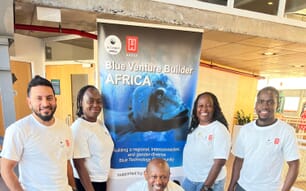Identity
Catla catla Hamilton, 1822 [Cyprinidae]
FAO Names: En - Catla
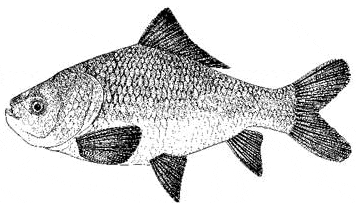
Biological features
Body short and deep, somewhat laterally compressed, its depth more than head length; head very large, its depth exceeding half the head length; body with conspicuously large cycloid scales, head devoid of scales; snout bluntly rounded; eyes large and visible from underside of the head; mouth wide and upturned with prominent protruding lower jaw; upper lip absent, lower lip very thick; no barbels; lower jaw with a movable articulation at symphysis, without a prominent process; gill rakers long and fine; pharyngeal teeth in three row, 5.3.2/2.3.5 pattern; dorsal fin inserted slightly in advance of pelvic fins, with 14 to 16 branched rays, the simple rays non-osseous; anal fin short; pectoral fins long extending to pelvic fins; caudal fin forked; lateral line with 40 to 43 scales. Greyish on back and flanks, silvery-white below; fins dusky.
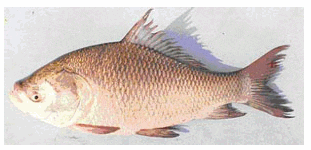
Profile
Historical background
Catla is endemic to the riverine system in northern India, Indus plain and adjoining hills of Pakistan, Bangladesh, Nepal and Myanmar, and has been introduced later into almost all riverine systems, reservoirs and tanks all over India. As the species breeds in the riverine ecosystem, its ready seed availability has helped in establishing its aquaculture in the peripheral region of the riverine system in these countries. The natural distribution of catla seems to be governed by temperature dependency rather than latitude and longitude. The minimum tolerance temperature limit is ~14 °C. The use of catla as a component in pond culture was a traditional practice in the eastern Indian states, spreading to all other Indian states only during the second half of the 20th century. Its higher growth rate and compatibility with other major carps, specific surface feeding habit, and consumer preference have increased its popularity in carp polyculture systems among the fish farmers in India, Bangladesh, Myanmar, Laos, Pakistan and Thailand. The collection of riverine seed was the only source for culture until the 1950s. Success in the induced breeding of the species in 1957 assured subsequent seed supply, thus revolutionising this form of polyculture in India and other south-east Asian countries. The species has also been introduced elsewhere, including Sri Lanka, Israel, Japan, and Mauritius. At present, catla forms an integral component species, both in three-species polyculture with rohu (Labeo rohita) and mrigal (Cirrhinus mrigala), and six-species composite carp culture, which adds common carp (Cyprinus carpio), grass carp (Ctenopharyngodon idellus) and silver carp (Hypophthalmichthys molitrix) to the species mix.
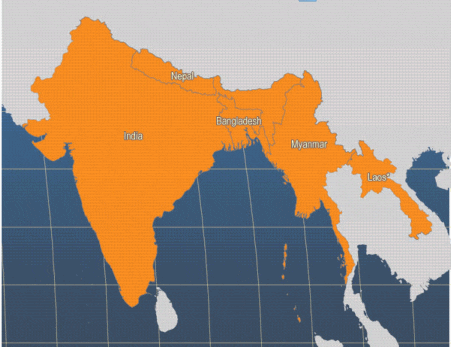
Habitat and biology
Catla is a eurythermal species that grows best at water temperatures between 25-32 °C.
The eggs are demersal at first, gradually becoming buoyant. Early-stage larvae remain in surface and sub-surface waters and are strongly phototactic. The larvae begin to feed three days after hatching, while their yolk sacs persist. As they increase in size, the number of gill rakers and gill filaments also increases, thus assisting them to strain ingested food items.
The fry are planktophagic, feeding mainly on zooplankton such as rotifers and cladocerans. Adults feed only in surface and mid-waters; they also are planktophagous, with a preference for zooplankton, mainly crustaceans, rotifers, insects and protozoa, as well as a considerable share of algal and plant material.
Catla attains maturity in its second year, performing a spawning migration during the monsoon season towards the upper stretches of rivers, where males and females congregate and breed in shallow marginal areas. The spawning season coincides with the south-west monsoon in north-eastern India and Bangladesh, which lasts between May and August, and in north India and Pakistan from June to September. Its fecundity generally varies from 100 000-200 000/kg BW, depending on fish length and weight. The resultant seed are brought by water flow to the downstream areas where they are caught by seed collectors.
Since a riverine environment is required, natural breeding does not occur within ponds, even though the species attains maturity; thus hormonal induction is required. Among the three Indian major carps, catla is the most difficult to breed as it requires precise environmental conditions for spawning. Under normal conditions catla grows to 1-1.2 kg in the first year, compared to 700-800 g and 600-700 g for rohu and mrigal, respectively. It attends sexual maturity in two years.
Production
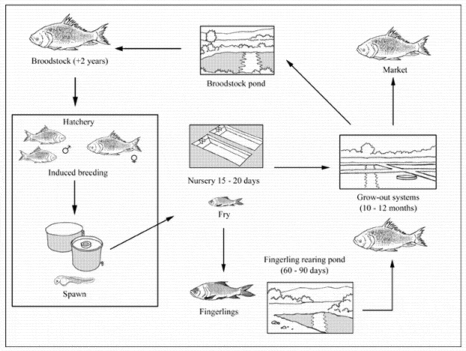
Production systems
Catla, the second most important species after rohu (mrigal is third), is used as the surface feeder component in Indian major carp polyculture systems. In the six-species composite system with rohu, mrigal, common carp, grass carp and silver carp, catla shares the upper feeding niche of the pond with silver carp. In the three-species system in India the proportion of catla stocked is usually kept at 30-35 percent, while in six-species culture it forms 15-20 percent. In a two-species commercial carp production system practised in the Koleru lake region of Andhra Pradesh, the major carp producing region in India, stocked catla constitute 20-30 percent of the total, the rest being rohu. In Bangladesh, though the three Indian major carps form the principal component species in polyculture systems, silver carp, grass carp, common carp, orange-fin labeo (Labeo calbasu), tilapia (Oreochromis mossambicus and O. niloticus) and several minor carps are also stocked. Another Chinese carp, bighead (Hypophthalmichthys nobilis) forms a component species in carp polyculture in Myanmar and Nepal.
Seed supply
Induced breeding of catla has been catering for almost the entire seed requirement in all the countries where it is cultured, although riverine collection still forms the seed source in certain small areas. Hormonal stimulation for induced breeding often gives poor result in catla, compared to other major Indian carps. This poor breeding response, coupled with a relatively shorter spawning season, results in an inadequate production of hatchery-reared seed, which often fails to cover the entire needs of the farmers in several regions. While carp pituitary extract has been the common inducing agent used since the development of the induced breeding technology, several synthetic commercial formulations of purified salmon gonadotropin and dopamine antagonist such as Ovaprim, Ovatide and Wova-FH have also been successfully used in recent years. When pituitary extract is used, females are injected with a stimulating dose of 2-3 mg/kg BW followed by a second dose of 5 to 8 mg/kg after a lapse of 6 hours; males are given a single dose of 2-3 mg/kg at the time of second injection of the female. When synthetic formulations are used, a single dose of 0.4-0.5 ml/kg BW (females) or 0.2-0.3 ml/kg (males) is administered.
Though various types of hatchery systems have been tried over the years, the Chinese circular hatchery has proved to be the most efficient for large-scale seed production. Broodstock, stocked at 3-5 kg/m3 and in a female:male ratio of 1:1 by weight (1:2 by number) are injected with suitable inducing agents and released into a breeding tank with a water depth of about 1.5 m. The fertilized eggs, collected 8-12 hours later, are transferred to the hatching tank and kept for 64-72 hours for further incubation and hatching. The number and size of the hatching tanks in this type of hatchery varies, based on the production requirements and size of the breeding tank. In general, spawn recovery varies from 0.1-0.12 million eggs/kg of female broodstock. The seed rearing normally involves a two-tier system, i.e. a 15-20 days nursery phase for raising fry, followed by a 2-3 months phase for fingerling production.
Nursery
Three-day old larvae, measuring about 6 mm, are reared for 15-20 days in small earthen nursery ponds of 0.02-0.1 ha, during which they reach 20-25 mm. In certain areas, brick-lined or cement tanks are also used as nurseries. Where only catla are stocked, earthen nurseries are stocked at 3-10 million/ha and cement nurseries at 10-20 million/ha. In many cases, however, farmers stock multiple carp species due to the non-availability of sufficient ponds for separate stocking. Pre-stocking nursery pond preparation includes the removal of aquatic weeds and predatory fishes, followed by liming and fertilization with organic manures and inorganic fertilizers. The application of soap-oil emulsion, or repeated netting with a suitable mesh size, is used to eradicate aquatic insects before stocking. A powdered mixture of rice bran and oilcake is the common supplementary feed. Survival rates normally range from 30 to 40 percent; however, survival often remains low due to improper management. The non-availability of commercial feed, forcing the farmers to resort to the conventional bran-oilcake mixture, is another limiting factor for the growth and survival of fry. The survival level of catla in nursery ponds is normally lower than that for rohu and mrigal.
Rearing fingerlings
The nursery-raised fry of 20-25 mm are further reared for 2-3 months to 80-100 mm (6-10 g) fingerlings in earthen ponds of 0.05-0.2 ha. Catla fry are reared along with rohu and mrigala in equal proportions at combined densities of 0.2-0.3 million fry/ha. Pond fertilization with both organic and inorganic fertilizers, and supplementary feeding with the conventional mixture of rice bran and oil cake are the norm; however, the dosage and form of application vary with the farming intensity and inherent pond productivity. The overall survival in these fingerling rearing systems ranges from 60 to 70 per cent.
Ongrowing techniques
Being a surface feeder that is highly preferred by consumer, catla forms an integral component in carp polyculture systems in all the countries where it is reared, including India, Bangladesh, Pakistan, Nepal, Laos and Myanmar. It is the fastest growing species among the three Indian major carps. Standardised practice for grow-out in the carp polyculture system includes control of predatory and weed fish through the application of chemicals or plant derivatives; the stocking of fingerlings at a combined density of 4 000-10 000 fingerlings/ha; pond fertilization with organic manures such as cattle dung or poultry droppings and inorganic fertilizers; supplementary feeding with a mixture of rice/wheat bran and oil cake; and fish health monitoring and water management.
The level of adoption of these practices varies from country to country, depending mainly on the resource availability and the economic status of the farmers. Normally, the grow-out period is one year, during which it grows to about 1.0 kg. In the Koleru lake area of Andhra Pradesh, the centre of commercial carp farming activity in India with a production water area of over 100 000 ha, the grow-out period extends up to 18 months. In this area, stunted juveniles (i.e. fingerlings reared in crowded conditions for over one year, and 150-300 g in size) are used as the stocking material and the average size of catla harvested is 1.5-2.0 kg. The production levels recorded in carp polyculture systems usually remain at 3-5 tonnes/ha/yr, with catla contributing about 20-30 percent of the biomass.
The fry/fingerlings supplied for grow-out stocking by most of the carp hatcheries/nurseries mainly comprise mixed species, often with a very low proportion of catla; the poor breeding response and comparatively low nursery phase survival of catla is the reason for this. Poor or non-availability of fingerlings of suitable size is another important limiting factor that compels farmers to stock small-sized seed, often leading to poor survival. The high cost of commercial feeds and feed ingredients sometimes restrains the farmers from feeding the correct quantity, thus also limiting production.
Catla also forms one of the important components in the sewage-fed carp culture system practiced in an area totalling over 4 000 ha in West Bengal, India. In this form of culture, which includes multiple stocking and multiple harvesting of 300 g fish, primary treated sewage is provided to the fish ponds as the main input. Even without the provision of supplementary feed, this system produces 2-3 tonnes/ha/yr; with supplementary feeding, this can be increased to 4-5 tonnes/ha/yr.
Harvesting techniques
Consumers generally prefer catla to be large 1-2 kg. Thus, farmers often resort to harvesting this species only at the end of the culture period instead of during intermittent harvesting. In waterbodies where multiple stocking and multiple harvesting are practised, the harvesting of larger sized fish (over 500 g) is usually initiated after 6-7 months of culture, while the smaller ones are returned to the pond for further growth. Manually operated dragnets are the most commonly used gear for harvesting carps. Marketable sized fish are usually harvested through repeated netting. Cast nets are another important gear frequently used for partial harvesting of fish in small and backyard ponds.
Handling and processing
Catla are marketed mostly in local markets, where they are sold fresh. The marketing of this species mostly relies on domestic markets, where it is sold fresh. In large commercial farms where the harvest is considerable, fish, after washing thoroughly in water, are packed with crushed ice at 1:1 ratio in rectangular plastic crates (usually 60 cm x 40 cm x 23 cm in size). Long-distance transport of these ice-packed fish in insulated vans is a common practice in countries like India, where catla are even transported over 3000 km by road to fish-deficit regions. Post-harvest processing and value-addition of this species is almost non-existent at present in any of the producing countries.
Production costs
In general, carp are low-valued species fetching market prices of less than USD 1/kg at the producers' level; therefore, the use of major inputs such as seed, fertilizers and supplementary feed, besides labour costs, is kept to a minimum. Supplementary feed constitutes over 50 percent of the total input cost in carp polyculture; therefore, judicious feed management is of prime importance for enhancing profits. In extensive systems, with a targeted production level of 2-3 tonnes/ha, the cost of production is about USD 0.30/kg, while the costs increase to USD 0.5-0.6/kg in semi-intensive culture, where the targeted production is 4-8 tonnes/ha.
Diseases and control measures
| DISEASE | AGENT | TYPE | SYNDROME | MEASURES |
|---|---|---|---|---|
| Eye disease | Aeromonas liquefaciens | Bacterium | Eye, optic nerves and brain affected; cornea of eye vascularised & becomes opaque; subsequently eye ball gets putrefied, leading to death | Treat affected ponds with 0.1 ppm KMnO4, followed by 300 ppm lime |
| Ulcer | Aeromonas spp.; Pseudomonas spp. | Bacteria | Ulcerations; exophthalmia; abdominal distension | Destroy badly infected fish; disinfect affected ponds with 0.5 ppm solution of KMnO4; add sulphadiazine (100 mg/kg) or terramycin (75-80 mg/kg) to feed for 10-12 days |
| Columnaris | Flavobacterium columnaris | Bacterium | Raised white plaques, often with reddish peripheral zone leading to haemorrhagic spots on body | Dip treatment with 500 ppm KMnO4 |
| Dropsy | Aeromonas sp. | Bacterium | Body scales stretch out resembling pine cone; inflammation; ulceration; exophthalmia; abdominal distension | Disinfect affected ponds with 1 ppm KMnO4; dip treatment of 5 ppm KMnO4 for 2 minutes |
| Saprolegniasis | Saprolegnia parasitica | Fungus | Mould grows like cotton wool on body, penetrating into the muscle; morbid muscle rot | 3-4% NaCl bath; KMnO4 bath for 5 days at 160 mg/litre bath for five days; 1-2 mg/litre malachite green bath for 30 minutes to 1 hour; add formalin at 20 ml/litre to affected ponds |
| Branchiomyosis (gill rot) | Branchiomyces demigrans | Fungus | Fungus grows out through gill blood vessels and causes necrosis of surrounding tissues; yellow-brown discolouration & disintegration of gill tissues | Addition of quick lime (50-100 kg/ha) to affected ponds; in case of limited infections, use 3-5 per cent NaCl bath for 5-10 minutes, or 5 ppm KMnO4 bath for 5-10 minutes |
| Ichthyophthiriasis | Ichthyophthirius multifilis | Parasite(protozoan) | Skin, fin rays & operculum covered with white spores; sick fish keep rubbing against hard substratum | Dip in 1:5 000 formalin solution for 1 hour for 7-10 days or in 2 per cent NaCl for 7-10 days; affected ponds should be disinfected with quicklime at 200 kg/ha |
| Trichodiniasis | Trichodina reticulata; T. negre | Parasite(protozoan) | Invasion of parasites in skin & gill region | 2-3 per cent NaCl bath for 5-10 minutes or 4 ppm KMnO4 batch for 5-10 minutes; treat affected ponds with 25 ppm formalin |
| White gill spot disease | Thenohanellus catlae; Myxobolus bengalensis; M. catlae; M. hosadurgensis | Parasite(protozoan) | Weakness; emaciation; raising of scales along their posterior margins; scale loss; perforation of scales; loss of chromatophores | Reduce density; add yeast to feed (1 g/kg); 2-3 per cent NaCl bath |
| Dactylogyrosis and Gyrodactylosis | Dactylogyrus spp.; Gyrodactylus spp. | Parasites(monogenean trematodes) | Gill, fin & skin affected; excessive mucus secretion | 3-5 per cent NaCl dip treatment for 5-10 minutes; 100 ppm formalin bath; treat affected ponds with 25 ppm formalin or 4 ppm KMnO4 |
| Black spot or Diplostomiasis | Diplostomum pigmentata | Parasites (digenean trematode | Black nodules due to metacercarial cysts in the host body; infects eye and causes blindness | Remove resident molluscan population |
| Argulosis | Argulus sp. | Parasite (crustacean) | Parasites visible to naked eye attached to head & fin rays; haemorrhagic spots found in chronic cases | Drain and dry ponds showing severe Argulus infection; short duration 5 ppm KMnO4 dip; treatment with 'Butox' three times at 35 ml/ha-m at weekly intervals |
| Epizootic Ulcerative Syndrome | Aeromonas hydrophila; A. sorbia; Aphanomyces invadans | Bacteria and fungus | Bacteria and fungus | 200 kg/ha quicklime or 0.1 ppm CIFAX (a CIFA, India formulation) |
Suppliers of pathology expertise
The following are examples of locations where expertise can be accessed:
- Central Institute of Freshwater Aquaculture, India.
- Central Institute of Fisheries Education, Mumbai, India.
- College of Fisheries, Mangalore, India.
Statistics
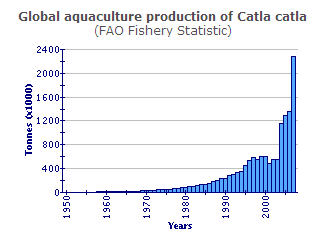
Farmed catla production peaked in 1999, at nearly 608 000 tonnes. India is by far the largest producer of catla but Bangladesh is also a major producer. Non-species-specific production statistics in several other countries has been a major constraint in assessing the actual farmed production of catla.
Market and trade
The market for catla is mainly local, where it is generally sold fresh, and often transported to nearby urban markets with ice. The fish are also transported in insulated vans with ice to fish-deficit areas of even 2 000-3 000 km distance from the production site. Moderate-sized fish of 1-2 kg are preferred because the taste declines as they get larger, due to their coarse texture. Catla and rohu fetch similar market prices, which are usually 10-20 percent higher than those for mrigal. Locally-produced fresh fish fetches about one and half times higher market price than iced-fish. Furthermore, when sold live, the market value increases over two-fold compared to iced fish. Governmental regulation and control over the domestic marketing system for these aquaculture products are almost non-existent; thus the market price is influenced mainly by demand and supply. Except for icing for transport, post-harvest processing is almost non-existent.
Status and trends
Several factors have enhanced the status of the farming of the Indian major carps:
- Improvements in induced breeding and seed production, which have removed the reliance on the capture of natural riverine seed.
- Improved grow-out technology.
- Improvements in feeding and health management.
On the other hand, while the inter-generic hybridisation of mrigal, rohu, catla, grass carp and common carp has been attempted, the hybrids did not show any genetic advantage over the parent stocks.
Other factors have caused problems. The adoption of intensive farming practices, unregulated use of inputs and lack of scientific know-how among the farmers has led to increased disease incidence. However, continued thrust on health management leading to development of therapeutics has helped the sector to overcome from such situations.
India has already drawn up a strategic plan for doubling freshwater aquaculture production through increases in productivity and area. Since catla forms an important component of the carp polyculture system, it can be expected that there will be a significant increase in its production in India by 2015. Bangladesh is also expected to enhance farmed catla production. The high growth potential of the Indian major carps has attracted the attention of several tropical South-Eastern Asian and Middle-Eastern countries.
Other factors are expected to influence further growth in the farming of Indian major carps, including:
- Selective breeding.
- Organic fish farming.
- Export to South-East Asian and Middle-East countries.
- Development of processing and value-added products.
The official production figures often do not represent a true picture, due to the lack of appropriate and uniform data collection mechanisms. The inadequate production statistical database has been an important drawback for the formulation of strategic development plans. The available information from several countries represents the total carp production, rather than that of individual species. Thus, uniform guidelines for database development would, to a great extent, help in the assessment of actual production and in the development of plans for the future.
Main issues
Carps are generally cultured in a closed system that involves herbivorous species, in which organic materials are used as the principal input sources, thereby making it a generally environmental-friendly practice. Furthermore, the compatibility of catla in polyculture systems with regard to habitat preference and feeding habits is good. However, the tendency of farmers to increase income per unit area has led to an excessive use of fertilizers, proteinaceous feeds and chemicals that may have detrimental effects on the environment. The compatibility of catla in polyculture systems with other carps has already been established. However, low breeding response of catla has been experienced in several regions; this, together with the low survival of this species in the nursery stages compared to rohu and mrigal, sometimes leads to shortages in seed supply.
Responsible aquaculture practices
Being a low input-based system, carp culture has not generally been perceived as a threat to the environment. However, increased emphasis on intensification for enhancing production in recent years has resulted in increased use of chemical fertilizers, feeds, therapeutics, drugs, chemicals, etc., which pose some concern. It is therefore necessary that the practicing countries should formulate guidelines and impose strict regulatory measures for the judicious use of these critical inputs. Application of the principles of Article 9 of the FAO Code of Conduct for Responsible Fisheries would be appropriate.
December 2009




